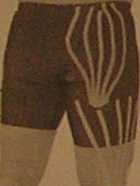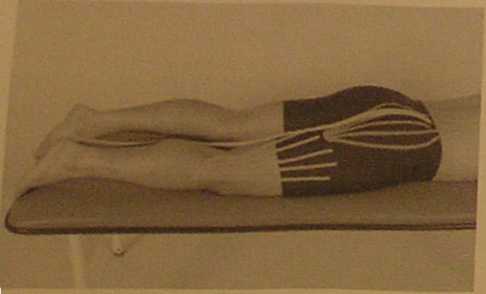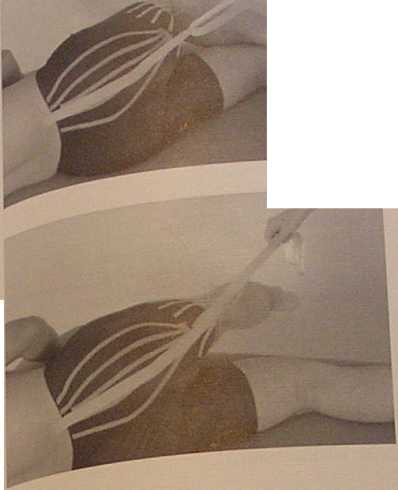P5140084
Sciatica
is an inflammation to the sciatic nerve which is generally associated with Iow back pain resulting from neurological sympłoms. Sciatica nerve invo!vement may be the result of inflammation occurring directly to the ner\'e itself, lumbar disk hemiation, or tightncss of the piriformis.
The Kinesio taping method will assist by reducing effusion, inflammation, pain and paresthesia. A lymphatic correction will assist with edema reduction and thcn the length of the sciatic nerve involve-ment will be taped along its dermatome.
Two options not show: 1) use of a star space correction technique to remove lymphatic fluid (see disk hemiation ,and 2) basie Kinesio taping technique for piriformis muscle (see myofascial Iow back)

K

Application of lymphatic correction strip, for complete review see lymphatic correction techniaue.
Begin the first Kinesio fan strip inferior to the ischial tuberosity. Have the patient moye into as much hip flexion as possible. Apply the fan strips with light, 0-15 % of available tension, tension accross the region of pain. Ending at approximately the sacroilliac joint.
Intitiate glue activation prior to any further patient movement.
Begin the second Kinesio fan strip inferior to the popliteal space. Have the patient move into as much hip flexion as possible. Apply the fan strips with light, 0-15 % of available tension, tension acrossthe region of pain. Ending inferior to the base of the first strip.
Initiate glue activation prior to any further patient movement.
W

The sciatica nerve strip can be initiated from either the hip or foot. The importance is that with each segmental application of the sciatica strip the segment must be placed in a stretched posi tion prior to tape application.
Beginning at the hip, apply the first two inchesof the Kinesio I strip, 1" width, at the PSIS.
The sciatica strip only needs to be applied as far down the leg as the radiating pain is felt by the patient.


Place the patient in hip flexion with forward flexton to the back.
Apply the Kinesio I strip with 15-25% of available, paper off, tension along the middle aspect of the posterior thigh. The Kinesio strip should follow the radiating path of paresthesia.
With the hip remaining in a flexed position, have the patient move their knee into extension.
Continue the Kinesio 1 strip with 5-25% of avail-able, paper off, tension along the radiating pathway.
While the hip remains in a flexed position, have the patient move their ankle into dorsiflexion.
Continue the Kinesio I strip with 5-25% of avail-able, paper off, tension along the radiating pathway.
Lay down the finał 2-3 inches of the Kinesio I strip with no tension.
123
Wyszukiwarka
Podobne podstrony:
P5140106 Achilles Tendonitis or Tenosynovitis Achilles tendonitis is an inflammation to the Achilles
085 (8) ler Herc is an alternatine to the cul-and-sewflowers on page 66. Thisflower is madę i„ crocl
An introduction to the graph theory A graph is a set of points, together with a set of arcs that con
P5140103 Pes Anserinus Bursitis or Tendonitis Pes anserinus bursitis or tendonitis is an inflammatio
P5140109 Sever s Syndrome or Apophysitis of the Calcaneus Scver s syndrome is an inflammation of the
P5140120 Plantar Fasciitis Plantar Fasciitis is an inflammation of the plantar aponeurosis. Pain and
f36 2 □ Netscape: Rdd an Item to the
1453823d585a6836c69176b4160ed309 verb noun Plcase provide a statement of why you a
136 ZAąCdir* Hajn union may submit a disputc to the arbitration board, which is cqual ta gmng up thc
Blenkinsopp, J., The Pentatech. An Introduction to the First Five Books of the Bibie, New York 1992
Ch. Veder (Orał discussion) PROPOSAL FOR AN INVESTIGATION WHETHER THE CLAY LAYER SUB-JACENT TO THE C
Written Arabic An Approach to the?sic Structures A. F. L. BEESTONWRITTENARABIC Ai APPROACH TO THE BA
Drawing for Interior Design I ID203, 2 credits This course offers an introduction to the process of
MA 7550 HUNT, Hugh: The Live Theatre. An introduction to the history and practice of the stage. Lond
więcej podobnych podstron